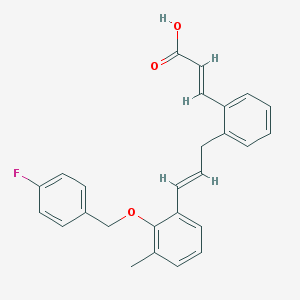

You can:
| Name | CHEMBL180089 |
|---|---|
| Molecular formula | C26H23FO3 |
| IUPAC name | (E)-3-[2-[(E)-3-[2-[(4-fluorophenyl)methoxy]-3-methylphenyl]prop-2-enyl]phenyl]prop-2-enoic acid |
| Molecular weight | 402.465 |
| Hydrogen bond acceptor | 4 |
| Hydrogen bond donor | 1 |
| XlogP | 6.4 |
| Synonyms | BDBM50159762 (E)-3-(2-{(E)-3-[2-(4-Fluoro-benzyloxy)-3-methyl-phenyl]-allyl}-phenyl)-acrylic acid |
| Inchi Key | AVHQUWRUVYEDCE-BHJHLDTFSA-N |
| Inchi ID | InChI=1S/C26H23FO3/c1-19-6-4-10-23(26(19)30-18-20-12-15-24(27)16-13-20)11-5-9-21-7-2-3-8-22(21)14-17-25(28)29/h2-8,10-17H,9,18H2,1H3,(H,28,29)/b11-5+,17-14+ |
| PubChem CID | 44390831 |
| ChEMBL | CHEMBL180089 |
| IUPHAR | N/A |
| BindingDB | 50159762 |
| DrugBank | N/A |
Structure |  |
| Lipinski's druglikeness | This ligand has a partition coefficient log P greater than 5. |
You can:
| GLASS ID | Name | UniProt | Gene | Species | Length |
|---|---|---|---|---|---|
| 15306 | Prostaglandin E2 receptor EP1 subtype | P34995 | PTGER1 | Homo sapiens (Human) | 402 |
| 15304 | Prostaglandin E2 receptor EP2 subtype | P43116 | PTGER2 | Homo sapiens (Human) | 358 |
| 15307 | Prostaglandin E2 receptor EP3 subtype | P43115 | PTGER3 | Homo sapiens (Human) | 390 |
| 15305 | Prostaglandin E2 receptor EP4 subtype | P35408 | PTGER4 | Homo sapiens (Human) | 488 |
zhanglab![]() zhanggroup.org | +65-6601-1241 | Computing 1, 13 Computing Drive, Singapore 117417
zhanggroup.org | +65-6601-1241 | Computing 1, 13 Computing Drive, Singapore 117417